by Heather Kent | Jul 4, 2022
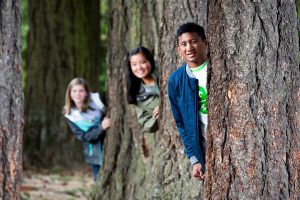 In a recent study, one of the top things 4-H volunteers are looking for are ideas for adapting activities to different age groups (Kent, 2022). Florida 4-H offers experiences for four different age groups: Cloverbuds (ages 5-7), Juniors (ages 8-10), Intermediates (ages 11-13) and Seniors (ages 14-18). One of the great things about 4-H is that the whole family can participate! This also means that 4-H volunteers often find themselves working with a variety of age groups. That might seem a little overwhelming, but this post series gives practical tips and strategies to make it less daunting. This week’s post is focused on adapting activities for intermediate-age 4-H members. In case you missed it, check out the previous couple of weeks posts to learn about cloverbuds and juniors.
In a recent study, one of the top things 4-H volunteers are looking for are ideas for adapting activities to different age groups (Kent, 2022). Florida 4-H offers experiences for four different age groups: Cloverbuds (ages 5-7), Juniors (ages 8-10), Intermediates (ages 11-13) and Seniors (ages 14-18). One of the great things about 4-H is that the whole family can participate! This also means that 4-H volunteers often find themselves working with a variety of age groups. That might seem a little overwhelming, but this post series gives practical tips and strategies to make it less daunting. This week’s post is focused on adapting activities for intermediate-age 4-H members. In case you missed it, check out the previous couple of weeks posts to learn about cloverbuds and juniors.
What are “Ages & Stages” and Why Does it Matter?
“Ages & stages” is a phrase commonly used in youth development that refers to the physical, social, emotional, and cognitive development of a young person. These categories of development are based on the work of researchers such as Piaget and Erickson. Understanding these categories help 4-H volunteers and professionals provide opportunities for youth to thrive through social and emotional learning and are a key part of the 4-H Thrive Model (Arnold & Gagnon, 2020). There are several benefits of selecting (or adapting) age-appropriate activities for youth:
- First, it makes learning fun! Fun is important; boring is bad.
- Youth are more engaged. When activities are not too challenging or too easy, they are in what’s called the “zone of proximal development,” or ZPD (Vygotsky, 1978). This is key to help learners master new skills. ZPD refers to skills or knowledge that are too difficult for a youth to master on their own, but possible to master with guidance from a more knowledgeable person- like their 4-H volunteer!
- Youth can build on past learning experiences and create future opportunities to grow.
- When learning is fun and youth are engaged, youth stay involved in 4-H!
How to Use “Ages & Stages” to help Intermediates Thrive
Social Development of 11-13 year-olds (how they act)
Youth who are 11-13 years old are undergoing several physical changes associated with puberty. Along with the physical changes, youth this age often struggle with personal identity. During this time, adolescents either establish their own sense of self or become confused with who they are and what they want to do in life. Helping youth discover their sparks- their own passions and interests- can help them form their self-identity.
| Typical social behaviors for 11-13-year olds include: |
Strategies for supporting social development of 11-13-year olds: |
- Developing their self-identity – what makes them unique
- Self-conscious because of puberty and the concept of self-image
- Wants more freedom from parental control and the power to make some of their own decisions
- Still likes to participate as a member of a group but now aware of and exploring the different roles (leader, participant, supporter, etc.) in a group
- Seeks peer group acceptance like before, plus now, status matters
- Understands the benefits of sharing and working together.
|
- Provide opportunities to share, learn and explore people’s different values, abilities, uniqueness, etc. so they can begin to identify their own
- Engage youth in healthy living discussions about self-image and puberty
- Extend the teamwork discussion and encourage youth to talk about different roles and the status we attach to these roles.
- Give youth the opportunity to plan, implement and evaluate 4-H activities.
- Incorporate teamwork as a component of your 4-H activities, allowing for discussion of roles, and for participants to try different roles.
- Foster a sense of belonging in which youth are accepted, encouraged, and supported by their peers.
|
Cognitive Development of 11-13-year olds (how they think)
Youth who are 11-13 years old can think logically and apply abstract reasoning. They can also manipulate mental representations. This is a great age to introduce youth to more complex ideas- particularly related to social and scientific issues that may impact their community. One way for youth in this age group to learn is through service-learning. Where they identify a problem in their neighborhood, school, or community, brainstorm solutions, select one, and implement and evaluate it.
| Typical learning behaviors for 11-13-year olds include: |
Strategies for Supporting Cognitive Development of
11-13-year olds: |
- Enjoys exploring ideas and these can be abstract or virtual
- Challenges norms, questions what is right and wrong, reasons, etc.?
- Learns best when new ideas are linked to their interests
- Able to multi-task
- Able to plan a whole event (with supervision)
|
- Engage in current events that have a right and wrong aspect, and ask them, “Thinking about this, can you come up with some reasons when someone could consider this wrong and when it could be right?”
- Engage teens in County & District Council, activities, teams, events, & projects.
- Encourage teens to identify their interests, and further explore them by allowing them to select their projects, events, etc.
- Empower teens to lead and plan a wide range of activities, encouraging them to be creative and put their own “twist”
- Engage teens in exploring what a positive body image, self-esteem, identity, etc. looks like – focus on many answers and this differs for each person
|
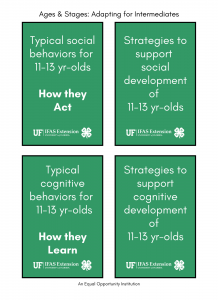 Ages & Stages Application Examples
Ages & Stages Application Examples
Throughout this series, we have been using examples from each of the three pillar programs in 4-H: Citizenship & Leadership, Science, and Healthy Living. These examples are meant to help parents and volunteers see how an activity can be adapted for each of the different age groups. For examples for other age groups, check out our previous post about Cloverbuds and our post about working with Juniors.
- Citizenship & Leadership: For citizenship & leadership, we have been using the example of a 4-H club business meeting. Eleven to 13-year-olds are going to be more interested in learning about leadership roles. Once they have some experience leading meetings at the club level, encourage them to get involved in the county and/or district leadership 4-H council. At this age, they can easily understand the proper order of a business meeting and how to make a motion. Encourage them to model this behavior to younger youth in the club. They may also be interested in leading a committee. Encourage them to be involved in planning club celebrations, fundraisers, and especially service projects.
- Science: For science, we have been using the 4-H entomology project as an example. Entomology is the study of insects. Eleven to 13-year-olds can catch, identify, and pin insects to create an insect collection. This collection could be exhibited at their county or regional fair, and can also be used as part of the 4-H Insectathon contest. Youth this age would enjoy competing in a state event like this!
- Healthy Living: For Healthy Living, we have been using the 4-H personal wellness project as an example. This project area helps youth learn about nutrition, physical fitness, and mental health. For intermediates, ask them to identify a problem at their school or community that has to do with personal wellness. Have them brainstorm solutions, select one, and plan a service project to address the need. After they implement the project, celebrate their accomplishments and help them evaluate and reflect upon their success.
Using the “Ages & Stages” approach with youth reinforces the Essential Elements of 4-H: Belonging, Mastery, Independence, and Generosity. This is also key to helping youth thrive. However, each individual youth grows at their own pace and might not completely meet the general tendencies listed above. As volunteers and 4-H professionals, it is important to observe youth and meet them where they are physically sociality, and intellectually. Adapting activities on the fly gets easier with practice- download this set of flashcards for a quick reference guide You can print them, cut them out, and punch them to fit on a lanyard as a handy teaching aid. Your local 4-H agent is always available to help and provide additional resources if you have questions.
References:
Arnold, M. E. & Gagnon, R. J. (2020). Positive youth development theory in practice: An update on the 4-H Thriving Model. Journal of Youth Development, 15(6), 1-23.
Erikson, E. H. (1963). Childhood and Society (2nd Ed.). New York: Norton.
Kent, H.C. (2022). Informal learning to support volunteer performance. [Unpublished doctoral dissertation]. Florida State University.
Lee, F. and Go, C. (2002). Developmental stages. UC ANR 4-H Youth Development Program.
Piaget, J. (1971). The theory of stages in cognitive development. In D. R. Green, M. P. Ford, & G. B. Flamer, Measurement and Piaget. McGraw-Hill.
Pleskac, S. (2000). Educational design and delivery: Use of age-appropriate activities. VRKC fact sheet.
Vygotsky, L. S. (1978). Mind in society: The development of higher psychological processes. Cambridge, MA: Harvard University Press.
by Heather Kent | Jul 3, 2022
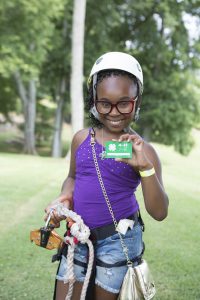 In a recent study, one of the top things 4-H volunteers are looking for are ideas for adapting activities to different age groups (Kent, 2022). Florida 4-H offers experiences for four different age groups: Cloverbuds (ages 5-7), Juniors (ages 8-10), Intermediates (ages 11-13), and Seniors (ages 14-18). 4-H encourages family involvement and engagement, and volunteers often find themselves working with a variety of age groups. That means that often, volunteers find themselves adapting activities on the fly to meet the needs of each youth. That might seem a little overwhelming, but this post series gives practical tips and strategies to make it less daunting. This week’s post is focused on adapting activities for junior age 4-H members. In case you missed it, check out last week’s post on adapting activities for Cloverbuds. This post also includes free downloadable flashcards as a handy reference tool!
In a recent study, one of the top things 4-H volunteers are looking for are ideas for adapting activities to different age groups (Kent, 2022). Florida 4-H offers experiences for four different age groups: Cloverbuds (ages 5-7), Juniors (ages 8-10), Intermediates (ages 11-13), and Seniors (ages 14-18). 4-H encourages family involvement and engagement, and volunteers often find themselves working with a variety of age groups. That means that often, volunteers find themselves adapting activities on the fly to meet the needs of each youth. That might seem a little overwhelming, but this post series gives practical tips and strategies to make it less daunting. This week’s post is focused on adapting activities for junior age 4-H members. In case you missed it, check out last week’s post on adapting activities for Cloverbuds. This post also includes free downloadable flashcards as a handy reference tool!
What are “Ages & Stages” and Why Does it Matter?
“Ages & stages” is a phrase commonly used in youth development that refers to the physical, social, emotional, and cognitive development of a young person. These categories of development are based on the work of researchers such as Piaget and Erickson. Understanding these categories help 4-H volunteers and professionals provide opportunities for youth to thrive through social and emotional learning and is a key part of the 4-H Thrive Model (Arnold & Gagnon, 2020). There are several benefits of selecting (or adapting) age-appropriate activities for youth:
- First, it makes learning fun! Fun is important; boring is bad.
- Youth are more engaged. When activities are not too challenging or too easy, they are in what’s called the “zone of proximal development,” or ZPD (Vygotsky, 1978). This is key to helping learners master new skills. ZPD refers to skills or knowledge that are too difficult for a youth to master on their own, but possible to master with guidance from a more knowledgeable person- like their 4-H volunteer!
- Youth can build on past learning experiences and create future opportunities to grow.
- When learning is fun and youth are engaged, youth stay involved in 4-H!
How to Use “Ages & Stages” to help Juniors Thrive
Social Development of 8-10 year-olds (how they act)
Youth who are 8-10 years old are learning how to be competent at activities valued by adults or their peers. When they struggle with competence, it is easy for them to feel inferior. It is best not to compare one youth to another. Instead, focus on how youth improve over time. Use the “oreo” method to compliment them on something they do well, then give them some constructive feedback, followed by another compliment.
| Typical social behaviors for 8-10-year-olds include: |
Strategies for supporting social development of 8-10-year-olds: |
- Participates as a member of a group and contributes to the group effort
- Still prefer same-gender friendships of short duration, often moving from one friend group to another
- Peer group acceptance is important
- Understands and practice sharing
|
- Help youth identify “what they are good at.” This ties in really well with sparks to create a strong environment for positive youth development
- Focus on helping youth achieve their personal best, such as comparing this month’s archery score with last month’s score. Avoid comparing youth to each other.
- When working with mixed-gender groups, provide opportunities for same-gender activities
- Encourage youth to recognize peers’ accomplishments, not just their own.
|
Cognitive Development of 8-10-year-olds (how they think)
Youth who are 8-10 years old are beginning to learn how to think more abstractly. They can now think in terms of cause and effect and understand the logic behind concrete events. They are also beginning to be able to “see” mental representations of ideas or concepts, such as the water cycle.
| Typical learning behaviors for 8-10-year-olds include: |
Strategies for Supporting Cognitive Development of 8-10-year-olds: |
- The attention span of about 40 minutes
- Likes to explore ideas especially if related to a hands-on or concrete experience
- Can do simple multi-tasking
- Learns best when new ideas are related to a piece of previous knowledge or experience
- Understands reasons behind right and wrong and can apply it
- Able to develop simple plans
- Beginning to understand give and take
- Interest expands beyond the home to extend to neighborhood and community
- Beginning to see people as individuals with unique thoughts, ideas, beliefs, and values
|
- Continue to keep youth engaged by using different teaching methods (e.g., hands-on, watch a video, pair off, etc.)
- Start your activities with the hands-on experience as much as possible, and keep instructions simple and brief
- Present a new idea or activity by referring to things that the youth already know such as “last month we learned about different types of horse feed. This month we are going to learn about the digestive system of a horse by building a model”
- Avoid telling youth about right or wrong, instead, ask them why this could be right or wrong…
- Engage youth in planning but set reasonable expectations – do not expect them to plan a whole event.
- Use community service opportunities to help youth learn about their neighborhood
- Engage youth to share their family traditions, customs, values, etc.
|
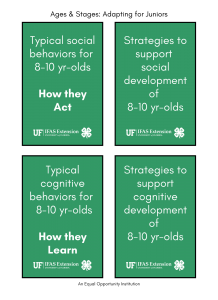
Examples of Ages & Stages Applied for Juniors
Throughout this series, we have been using examples from each of the three pillar programs in 4-H: Citizenship & Leadership, Science, and Healthy Living. These examples are meant to help parents and volunteers see how an activity can be adapted for each of the different age groups. For examples for other age groups, check out our previous post about Cloverbuds.
- Citizenship & Leadership: For citizenship & leadership, we have been using the example of a 4-H club business meeting. Eight to 10-year-olds can follow the club meeting script to begin to learn about the order of a business meeting. You can write a different role on popsicle sticks, then ask youth to draw a role at the beginning of each meeting. Y This way, they begin to learn about leadership roles and the business meeting model without the pressure of needing to know what to say. Eight to 10-year-olds will also want to be involved in committee work, led by an older, more experienced youth or with the help of a parent volunteer. During committee meetings, allow youth to plan parts of club events such as celebrations, fundraisers, or service projects.
- Science: For science, we have been using the 4-H entomology project as an example. Entomology is the study of insects. Eight to 10-year-olds can catch and begin to identify insects using a simple key. They may also want to pin and display their insects at their county or regional fair. They could also team up with a friend and give an illustrated talk or demonstration about what they have learned about insects for their club or county events.
- Healthy Living: For Healthy Living, we have been using the 4-H personal wellness project as an example. This project area helps youth learn about nutrition, physical fitness, and mental health. For juniors, this could be an opportunity for them to explore other cultures through food. Ask different youth to share what their family’s favorite meals are. This is a great way for them to cultivate learning beyond their home to include their neighborhood and community.
Using “Ages & Stages” approach with youth reinforces the Essential Elements of 4-H: Belonging, Mastery, Independence, and Generosity. This is also key to helping youth thrive. However, each individual youth grows at their own pace and might not completely meet the general tendencies listed above. As volunteers and 4-H professionals, it is important to observe youth and meet them where they are physically sociality, and intellectually. Adapting activities on the fly gets easier with practice- download this set of flashcards for a quick reference guide. You can print them, cut them out, and punch them to fit on a lanyard as a handy teaching aid. Your local 4-H agent is always available to help and provide additional resources if you have questions.
References:
Arnold, M. E. & Gagnon, R. J. (2020). Positive youth development theory in practice: An update on the 4-H Thriving Model. Journal of Youth Development, 15(6), 1-23.
Erikson, E. H. (1963). Childhood and Society (2nd Ed.). New York: Norton.
Kent, H.C. (2022). Informal learning to support volunteer performance. [Unpublished doctoral dissertation]. Florida State University.
Lee, F. and Go, C. (2002). Developmental stages. UC ANR 4-H Youth Development Program.
Piaget, J. (1971). The theory of stages in cognitive development. In D. R. Green, M. P. Ford, & G. B. Flamer, Measurement and Piaget. McGraw-Hill.
Pleskac, S. (2000). Educational design and delivery: Use of age-appropriate activities. VRKC fact sheet.
Vygotsky, L. S. (1978). Mind in society: The development of higher psychological processes. Cambridge, MA: Harvard University Press.
by pmdavis | Jul 1, 2022
It’s hard to believe the 4th of July is already upon us!
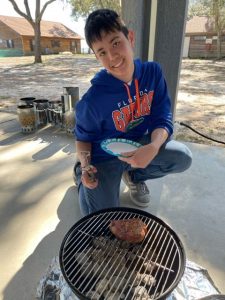
Youth learning to grill during 4-H tailgate program
Many of us will be celebrating with picnics, cookouts, and family get-togethers. One of my colleagues in Clay County, Samantha Murray, did a great article about preventing food poisoning while celebrating. Our youth have also been attending grilling summer camp programs and learning many of these tips plus lots more. The youth have learned about how to use a grill safely, how to prepare food safely and prevent cross-contamination or food-borne illness, and the nutritional benefits of animal protein in diets. Our district will have its annual competition to advance to the state-level competition on July 30 at the Washington County Extension Office, in Chipley, Florida.
I just wanted to take a moment to recap the tips Samantha gave to keep all of us safe and healthy while celebrating.
- Keep raw meats in a separate cooler than ready-to-eat items or beverages.
- Foods with mayonnaise are less acidic creating a better environment for bacterial growth
- Chicken and ground beef needs to be cooked to 165°F
- Wash hands if soap and water are not available use hand sanitizer to reduce the risk of contaminating food.
- Use different tongs or spatulas for cooked and uncooked meat or wash them after being in contact with raw meat.
- It is recommended to refrigerate leftovers within two hours unless it’s really hot, then the window shrinks to about an hour.
Other items you may want to think about.
- Keep beverages in a separate cooler from other foods, people will be going in and out of beverage coolers much more keeping the temperature higher and allowing bacterial growth.
- Cook cuts of pork, beef, or shrimp to 145°F
- Don’t sit charcoal grills on plastic tables and make sure the area is free from debris that can catch fire, including limbs or tents overhead.
- Clean up after yourself leaving only footprints in the area you were in!
- Enjoy time with friends and family safely!
For more information about educational programs, check out our webpage or contact your local UF IFAS Extension Office.
by Heather Kent | Jul 1, 2022
 In a recent study, one of the top things 4-H volunteers are looking for are ideas for adapting activities to different age groups (Kent, 2022). Florida 4-H offers experiences for four different age groups: Cloverbuds (ages 5-7), Juniors (ages 8-10), Intermediates (ages 11-13) and Seniors (ages 14-18). 4-H encourages family involvement and engagement, and volunteers often find themselves working with a variety of age groups. Each of these age groups have unique needs related to their social and cognitive development. Over the next few weeks, our blog will provide tips and ideas for adapting 4-H curriculum and activities to meet these needs.
In a recent study, one of the top things 4-H volunteers are looking for are ideas for adapting activities to different age groups (Kent, 2022). Florida 4-H offers experiences for four different age groups: Cloverbuds (ages 5-7), Juniors (ages 8-10), Intermediates (ages 11-13) and Seniors (ages 14-18). 4-H encourages family involvement and engagement, and volunteers often find themselves working with a variety of age groups. Each of these age groups have unique needs related to their social and cognitive development. Over the next few weeks, our blog will provide tips and ideas for adapting 4-H curriculum and activities to meet these needs.
What are “Ages & Stages” and Why Does it Matter?
“Ages & stages” is a phrase commonly used in youth development that refers to the physical, social, emotional, and cognitive development of a young person. These categories of development are based on the work of researchers such as Piaget and Erickson. Understanding these categories help 4-H volunteers and professionals provide opportunities for youth to thrive through social and emotional learning and is a key part of the 4-H Thrive Model (Arnold & Gagnon, 2020). There are several benefits of selecting (or adapting) age-appropriate activities for youth:
- First, it makes learning fun! Fun is important; boring is bad.
- Youth are more engaged. When activities are not too challenging or too easy, they are in what’s called the “zone of proximal development,” or ZPD (Vygotsky, 1978). This is key to helping learners master new skills. ZPD refers to skills or knowledge that are too difficult for a cloverbud to master on their own, but possible to master with guidance from a more knowledgeable person- like their 4-H volunteer!
- Youth can build on past learning experiences and create future opportunities to grow.
- When learning is fun and youth are engaged, youth stay involved in 4-H!
How to Use “Ages & Stages” to help Cloverbuds Thrive
Social Development of 5-7-year-olds (how they act)
Youth who are 5-7 years old are learning how to develop their own initiative. Giving them opportunities to initiate activities and learn from others is important. Instead of telling them what to do every time, provide them with a chance to ask questions and develop initiative- when they do, be sure to recognize their efforts and encourage them.
| Typical social behaviors for 5-7-year-olds include: |
Strategies for supporting social development of 5-7-year-olds: |
- Tendency to be self-centered, but starting to learn to share
- Learning to be a group member: to listen when others speak
- Want to be liked, especially by older youth and adults
|
- Use role-playing opportunities to act out scenarios
- Limit activities to small groups to allow peer and adult interactions; UF requires a supervision ratio of one adult for every eight cloverbud age youth.
- Be intentional about recognizing youth accomplishments (even the little things)
- Focus on activities that are cooperative rather than competitive to foster sharing and encouragement.
- Build-in unstructured time for play and creativity (follow the 4-H club model: short business meeting, educational program, and time for recreation).
|
Cognitive Development of 5-7-year-olds (how they think)
Youth who are 5-7 years old are usually still egocentric- that means they typically think about things only from their personal point of view. They like to use symbols in play, and want to define and classify things by how they are used. It is hard for them to understand cause and effect relationships, and have difficulty multi-tasking.
| Typical learning behaviors for 5-7-year olds include: |
Strategies for Supporting Cognitive Development of 5-7-year-olds: |
- Their attention span is limited to 20-30 minutes (so keep those educational programs short, with breaks for play in-between).
- They learn best when they can be active while learning (no long lectures or PowerPoints, instead, short instructions with interactive activities they can do with their hands).
- They enjoy doing simple sorting and categorizing- this can be a great way to teach new knowledge, such as the parts of a plant, or tool or animal identification)
- They are concerned with right and wrong, so explaining and enforcing basic ground rules is important.
|
- Use breaks and balance group and individual time to keep youth engaged
- As much as possible, use activities where youth can physically manipulate objects with their hands to learn
- Plan for simple activities, such as identifing types of butterflies instead of identifying types of insects which is more complex
- Help youth focus on the process, rather than the end product. For example, talk about how youth are learning how to identify different types of butterflies rather than how many they got correct.
- Model questioning and inquiry to help foster learning: “why do you think this butterfly has this type of pattern?”
|
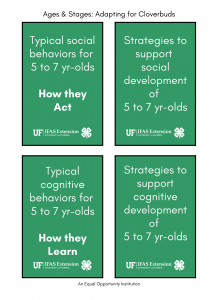
Examples of Adapting Activities for Cloverbuds. Throughout this series, we have been using examples from each of the three pillar programs in 4-H: Citizenship & Leadership, Science, and Healthy Living. These examples are meant to help parents and volunteers see how an activity can be adapted for each of the different age groups. For examples for other age groups, check out our posts about Juniors, Intermediates, and Seniors.
- Citizenship & Leadership: For citizenship & leadership, we have been using the example of a 4-H club business meeting. Five to 7 year-olds aren’t ready to serve in an executive leadership position. However, they can do things like lead the American and 4-H Pledges. They can also contribute ideas to help plan the club calendar. If you have a large number of Cloverbuds in your club, you will want to keep the business meeting short!
- Science: For science, we have been using the 4-H entomology project as an example. Entomology is the study of insects. Youth in the Cloverbud age range really enjoy categorizing and sorting things, so insect ID can be a fun way for them to engage. However, keep the categories simple; instead of handing them a dichotomous guide (that they probably can’t read). Ask them to identify insects with wings vs insects without wings. Or insects with different types of mouthparts, after explaining what the five basic mouthparts are.
- Healthy Living: For Healthy Living, we have been using the 4-H personal wellness project as an example. This project area helps youth learn about nutrition, physical fitness, and mental health. For Cloverbuds, exposing them to different types of fruits and vegetables is a fun way for them to learn about nutrition. For example, you could do a taste test of different types of apples and have them vote for their favorite. This age group would also enjoy growing some of their own food- so think about growing different types of lettuce (which grows quickly in the cooler months in Florida) or cucumbers in the hotter months.
Spending some time thinking about 4-H activities through the “Ages & Stages” lens reinforces the Essential Elements of 4-H: Belonging, Mastery, Independence, and Generosity. They are also key to helping youth thrive. However, each individual youth grows at their own pace and might not completely meet the general tendencies listed above. As volunteers and 4-H professionals, it is important to observe youth and meet them where they are physically sociality, and intellectually. Adapting activities on the fly gets easier with practice- download this set of flashcards for a quick reference guide. You can print them, cut them out, and punch them to fit on a lanyard as a handy teaching aid. Your local 4-H agent is always available to help and provide additional resources if you have questions.
References:
Arnold, M. E. & Gagnon, R. J. (2020). Positive youth development theory in practice: An update on the 4-H Thriving Model. Journal of Youth Development, 15(6), 1-23.
Erikson, E. H. (1963). Childhood and Society (2nd Ed.). New York: Norton.
Kent, H.C. (2022). Informal learning to support volunteer performance. [Unpublished doctoral dissertation]. Florida State University.
Lee, F. and Go, C. (2002). Developmental stages. UC ANR 4-H Youth Development Program.
Piaget, J. (1971). The theory of stages in cognitive development. In D. R. Green, M. P. Ford, & G. B. Flamer, Measurement and Piaget. McGraw-Hill.
Pleskac, S. (2000). Educational design and delivery: Use of age-appropriate activities. VRKC fact sheet.
Vygotsky, L. S. (1978). Mind in society: The development of higher psychological processes. Cambridge, MA: Harvard University Press.
by pmdavis | Jun 17, 2022
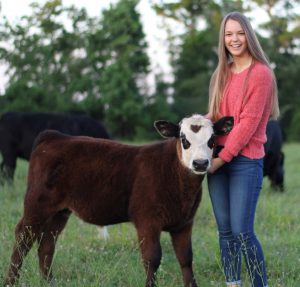
Taylor Yoder
Taylor Yoder is the daughter of David and Robin Yoder of Altha, FL. Taylor is a senior and has been homeschooled along with her 3 sisters. Her plan after graduating is to attend Chipola College and then pursue an ag business degree.
Taylor has been a member of the Jackson County 4-H club since 2017. Some of the events she has been a part of include Chopped Challenge, Holiday bake-offs, arts and crafts contest though the Panhandle Youth Expo, and is an active member of the livestock club. As a member of the livestock club, Taylor has participated in numerous judging contests across the Southeast. Her team was the third-place team in the 2022 state 4-H contest. In addition, she was the overall high individual in this contest.
In addition to these activities, Taylor helped start and holds a leadership role in the Jackson County Junior Cattleman’s Association, she has been a two-time state voting delegate for Jackson County 4-H, and is a board member for the Junior Florida Simmental Association.
Taylor is most passionate about cattle breeding, showing, and judging. Taylor had the reserve grand champion steer at the North Florida Fair in 2021 and exhibited the grand champion steer at this fair in 2022. She has also participated in the PYE steer show since 2017 and had the reserve champion steer in 2021. She has also won best county raised steer three times.
The thing that means the most to Taylor from being a part of 4-H is that it has prepared her to be able to face a challenge with confidence. Her time showing, judging, and giving reasons has helped to instill this confidence in her. These activities have created a love for cattle and has helped shape what her future will involve. Lifelong friendships and connections across the state have also played a huge role in her desire to pursue future endeavors in the cattle industry.
This story prepared by Patti Peacock, Jackson County 4-H
by Julie Pigott Dillard | Jun 10, 2022
With temperatures already posting in the 90s this month, it’s a good idea to make sure your backyard chickens are ready for the coming summer heat. Poultry can become heat stressed when temperatures rise above 80 degrees Fahrenheit. Heat stress affects egg production as well as size, shell quality, and hatchability. It also affects appetite and growth in younger birds.
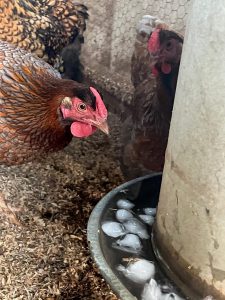
Add ice cubes to your chickens water to cool them down.
To minimize heat stress in your backyard flock, there are several things you can do.
- Make sure your coop is well ventilated for cross air movement. Trim vegetation and limbs that might block air flow. You can also add a fan to help move air throughout the coop.
- Locate your coop in a shaded area surrounded by grass. Grass reduces light reflection into the coop.
- Provide cool water in shaded locations for your birds. Ice cubes and frozen water bottles can help cool water down. Feed consumption will likely decrease during this time but shouldn’t give you alarm.
- Provide occasional frozen treats like watermelon and peas. Fill a container with fruit or vegetables, add water, and freeze. The chickens will peck at it as it thaws.
- Misters, shallow wading pools, and dust baths can help chickens cool down.
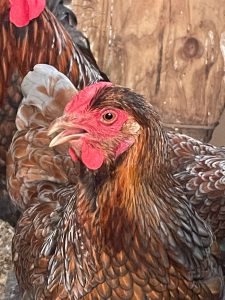
Chickens pant to dissipate heat from their bodies.
Chickens don’t sweat. Instead, they dissipate heat from their wattles, legs, under the wings and through panting. Watch out for signs of heat stress that might include
- heavy panting
- wings held out from the body
- lethargic, sluggish behavior
- pale combs and wattles.
To learn more about keeping your backyard chickens healthy during the summer, contact your local UF/IFAS Extension office.
by Marie Arick | Jun 7, 2022
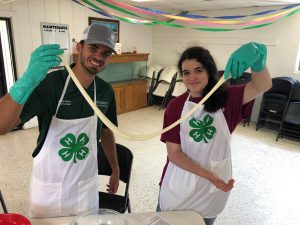
Mozzarella Cheese, 4-H U 2021
Youth participating in 4-H University can gain skills they can rely on for a lifetime! How do you ask? These youth (aged 14-18) get to explore numerous career opportunities by participating in educational workshops, lead community service projects, participate in competitive events, be recognized for their outstanding activities, and make friends with youth from across the state!
The weeklong 4-H University experience allows youth to self-select topics of interest and gain insightful experiences to explore these topics. This year’s tracks include livestock and dairy science to food science and culinary. Simply put, this is career exploration. These experiences are informative and introduce topics of interest that youth may want to consider as a career path. Many include the ‘learn by doing’ activities, for example making homemade mozzarella cheese, are designed to develop some life skills in the process. If that was not enough, there are competitive events such as illustrative talks and public speaking, a Share the Fun Contest that allows youth to share their talents with others, a campus tour for first -time attendees, and of course a youth banquet and a dance.
While speaking to a former 4-H State President, Mr. Matt Schmarje (99-00), he echoed the importance of 4-H University (at that time called Congress). By self-selecting workshops led to the introductions he had to numerous different topics and the building of life skills that he says have served him to this day. He then went on to express 4-H University also taught him team building skills, how to embrace people and their differences, and allowed him to develop and enhance his communication skills. The years he spent attending 4-H University allowed him to grow within the 4-H program through the many experiences that he has utilized in his life and career. Most importantly Matt emphasized how the accepting and embracing of other people and their differences opened his world to a variety of cultural experiences with people he is still friends with to this day.
If you would like more information on 4-H University, contact your local 4-H Agent or follow this link https://florida4h.ifas.ufl.edu/events/4-h-university/
by pmdavis | May 27, 2022

Jackson County 4-H Senior Dylan Ziglar
Dylan Conner Ziglar joined 4H Jackson County Livestock Club in 2012. Dylan has had opportunities to participate in poultry judging, meat judging and livestock judging earning many awards and ribbons. Dylan has participated in the Chick Chain project, State Poultry Judging Competition earning 2nd place high individual in 2019 and a spot on the Florida Team at the National Egg Poultry Conference with the Florida Team placing 6th in the country and was on the Florida National Livestock Skillathon Team. He has earned multiple individual and team awards in meat, poultry and livestock judging competitions in Florida, Georgia, and Alabama.
Dylan has also been a member of Marianna High School FFA participating in FFA poultry and meats judging competitions. He is a volunteer at Evangel Church in the audio/visual department. Dylan is a member of the Jackson County Junior Cattleman’s Association in Florida and currently serves as the secretary. In 2021 he was a vital member of the Jr Cattleman’s Quiz bowl Team placing first in the Cattleman’s convention Quiz bowl competition.
Dylan is a vital part of his family farm, The Lazy Acres Family Farm, in Marianna and is the operation manager of the swine operation and assists his parents in other farm chores and work. Following high school, Dylan plans to enroll at Florida Panhandle Technical College and pursue a certification as an electrician. Dylan’s dream is to one day be an entrepreneur/business owner.
To find out more information about 4-H programs that can offer essential life skills such as independence, organizational skills, and goal setting, to your children or to volunteer with 4-H, please contact your local UF/ IFAS County Extension Office.
Article Submitted by Doug Mayo and Patti Peacock
by Niki Crawson | May 20, 2022
Summer is right around the corner. As much as we all love the sunshine feeling on our face and body, too much of a good thing can be harmful! It is always important to remember our family’s well-being, take responsibility for our personal safety, and make healthy decisions, even while having a fun time. Here are some short sun safety reminders to make your summer a fun and enjoyable experience for you and your family members!
SUN SAFETY
Plan Your Day Around the Clock
The sun shares its most harmful rays in the middle of the day so plan this time for indoor use. The sun’s rays are most harmful between the hours of 10 AM and 4 PM so make outdoor time in the early morning or early evening when it is less intense. This also keeps your food at safer temperatures as well so your ice (or you) won’t melt as fast.
Protect Your Body
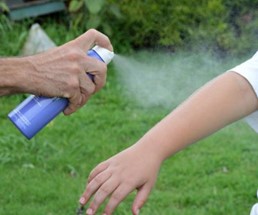
Look for SPF 30 or higher sunscreen.
One of the easiest defenses against the sun is sometimes one of the most forgotten, sunscreen! Be sure to lather up in sunscreen BEFORE you go outside. The American Academy of Dermatology recommends liberally applying a sunscreen that is at least SPF 30 or higher, as these formulas will block UVA and UVB rays. Be sure to apply at least 30 minutes prior to going outside. Once outside, continue to apply sunscreen every two hours or after swimming. Not sure what kind of sunscreen blocks UVA and UVB rays? Look for a sunscreen that is SPF 30 or higher with the ingredients zinc oxide or titanium dioxide as these ingredients will do the job. Remember to coat your ears, neck, tops of feet, etc.
Remember to grab your sunglasses too! Your eyeballs are just as sensitive as your skin so blocking UVA and UBA rays from your eyes are important to. Fashionable sunglasses are great if you are into that but being able to protect your eyes is the goal.
Limit Time

Remember to keep your pets cool too!
Most everyone enjoys getting outside this time of year to soak up some sunshine and enjoy the beautiful day. In fact, it’s true that some amount of sunlight is healthy for your body and mind. However, as we know all too well sometimes, too much exposure can be detrimental and lead to sunburn, heat exhaustion and more. Thus, it is a good idea to find balance by setting a time limit on sun exposure, if possible. If time slips past you because you and your family are having too much fun, set an alarm as a friendly reminder. Make this your “shade time” for a water break, game of cards, or a brief nap. Be sure to always have an umbrella or tent on hand in case no shade is available.
Hydrate
It is very easy to get dehydrated in the summertime. Drink water throughout the day. Don’t wait until you get hot and thirsty. Drink water to maintain your hydration before it is depleted. This will help avoid those nasty summer headaches and tummy aches. Taking your pet with you? Don’t forget Fido’s water bowl too!
4-H PROGRAMMING
UV Bead Activity
Looking for a really cool lesson to teach your children about the risk factors associated with sun exposure and UV rays? Check out this 4-H activity 4-H + Me = Health: Sun Safety from Minnesota Extension Service’s Exploring Your Body, Helper’s Guide. In this activity, children can make their own beaded bracelets that change colors when exposed to UV light. This is a great way for children to understand UV light, cloud coverage, sunscreen SPFs and more!

UV Beads with no sun exposure.
4-H has plenty of educational programming, both outdoors and indoors, to keep your children engaged this summer! From gardening to robots, archery to grilling, 4-H has something for everyone. If you are looking for fun, educational activities during the summer while maintaining a safe environment for your child, please contact your local UF IFAS County Extension Office, or visit http://florida4h.org
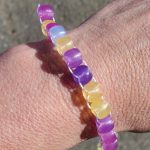
UV Beads with sun exposure.

by aschortinghouse | May 13, 2022
Horse Show
Youth from across north Florida gathered to compete at the 2022 Area
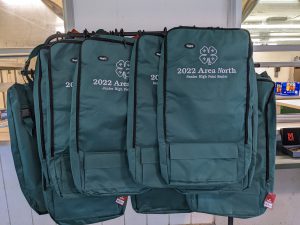
2022 Area North High Point Division Winners bridle bags.
North Horse Show in Clay County. Area shows take place throughout the state and serve as a qualifying show for the state show which takes place this summer. This is not just another horse show though, these 4-H Area shows are unique in that these shows are just one part of the larger project these youth are involved in. At the beginning of each year, youth declare which horses they will be working with. They are then responsible for working with their horses to learn more about equine sciences and to prepare for the various show and project opportunities such as workshops and shows. At the 2022 Area show, youth had the opportunity to participate in various disciplines including western, hunter, speed, and ranch divisions. Youth were eligible to earn ribbons, high points, and versatility awards. What youth are achieving inside the arena is second to that of what is being developed in our youth outside the arena.
Outside the Arena
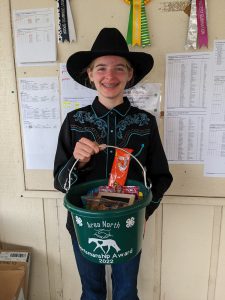
2022 Area North Horse Show Sportsmanship award winner.
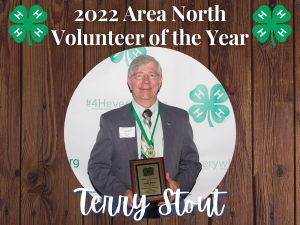
2022 Area North Volunteer of the Year.
In addition to the competition in the arena, youth and volunteers are recognized for their efforts outside the arena with various awards such as the sportsmanship and volunteer of the year awards. Horse projects and shows offer youth a chance to develop life skills, while loosing themselves in the magic of a horse. Horses demand responsibility, decision making, communication, among many other life skills. While some youth will be recognized for their success with ribbons, all of our youth are building skills that will carry them throughout their lifetimes. All of this though is not possible without the support and tireless effort put in by our volunteers. Thank you to all of our volunteers who made this even possible and congratulations to our 2022 volunteer of the year!
Congratulations to all the youth who competed and qualified for the State 4-H Horse Show later this year. To see a full list of qualifiers, click here. If you want to learn more about how you can get involved!
 In a recent study, one of the top things 4-H volunteers are looking for are ideas for adapting activities to different age groups (Kent, 2022). Florida 4-H offers experiences for four different age groups: Cloverbuds (ages 5-7), Juniors (ages 8-10), Intermediates (ages 11-13) and Seniors (ages 14-18). One of the great things about 4-H is that the whole family can participate! This also means that 4-H volunteers often find themselves working with a variety of age groups. That might seem a little overwhelming, but this post series gives practical tips and strategies to make it less daunting. This week’s post is focused on adapting activities for intermediate-age 4-H members. In case you missed it, check out the previous couple of weeks posts to learn about cloverbuds and juniors.
In a recent study, one of the top things 4-H volunteers are looking for are ideas for adapting activities to different age groups (Kent, 2022). Florida 4-H offers experiences for four different age groups: Cloverbuds (ages 5-7), Juniors (ages 8-10), Intermediates (ages 11-13) and Seniors (ages 14-18). One of the great things about 4-H is that the whole family can participate! This also means that 4-H volunteers often find themselves working with a variety of age groups. That might seem a little overwhelming, but this post series gives practical tips and strategies to make it less daunting. This week’s post is focused on adapting activities for intermediate-age 4-H members. In case you missed it, check out the previous couple of weeks posts to learn about cloverbuds and juniors. Ages & Stages Application Examples
Ages & Stages Application Examples

















